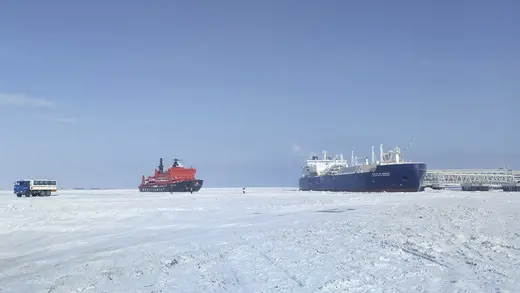In Brief
What’s at Stake With Rising Competition in the Arctic?
A changing climate and growing competition for resources is raising tensions among Arctic nations.
The Arctic evokes images of a harsh environment—snow, glaciers, and a frozen ocean that caps the top of the world. But this relatively peaceful and largely uninhabitable area is increasingly becoming the focus of international cooperation and competition. Climate change, globalization, and the return of great-power rivalry is turning the region into a geopolitical hot spot, and Washington should continue to partner with allies to set and enforce the rules.
What are the Arctic’s boundaries?
The Arctic region is defined by U.S. policy as all land and ocean north of the Arctic Circle (approximately 66.5° N latitude) plus the Aleutian Islands, the Bering Sea, and portions of western Alaska. Eight nations have territory in the region: Canada, Denmark (via Greenland), Finland, Iceland, Norway, Russia, Sweden, and the United States (via Alaska).
More on:
These countries share many interests, including the need to cooperate on search-and-rescue missions, enforce maritime safety regulations, and preserve the well-being of indigenous Arctic communities. However, there are growing divisions between Russian and the rest of the Arctic nations. China’s increasing assertiveness in the region also adds to the tension.
How is the region governed?
There is no single governing body for the Arctic. However, there are several organizations that loosely cooperate. The most successful has been the Arctic Council, a forum of the eight Arctic nations. The council’s work centers on environmental monitoring, support for indigenous communities, and emergency response; it does not deal with national security issues. With Russia set to assume the rotating chair for the 2021–2023 term, analysts will be watching closely for any changes in Russia’s behavior.
Other institutions, such as the Arctic Coast Guard Forum, North Pacific Coast Guard Forum, and various organizations for indigenous Arctic peoples, bring together all the Arctic states but also do not address security issues.
Those that do work on security-related topics now exclude Russia due to the broader isolation of Moscow resulting from its 2014 annexation of Crimea and invasion of eastern Ukraine. These include the North Atlantic Treaty Organization (NATO), the Arctic Security Forces Roundtable, and meetings of the Arctic defense chiefs.
What issues threaten Arctic security?
There are many thorny issues at play in the region. Technological advances in extracting natural resources including fish, rare earth metals, oil, and gas are driving a race for influence in the Arctic that could spur future conflicts. Furthermore, climate change is shrinking the ice pack, making it easier to access these resources. Even among allies, there remain minor disagreements over territorial and navigation rights. Another challenge is the expansion of military bases and deployments, which some Arctic nations see as necessary to protect their resources and logistics networks.
More on:
A prime example is the Russian port of Yamal on the Siberian coast, a major exporter of liquefied natural gas (LNG). In 2017, Yamal LNG began shipping across the Northern Sea Route (NSR) and through the Bering Strait to China, resulting in the emergence of a new strategic international energy corridor. In part to defend the NSR, there has been a rapid increase in military outposts along Russia’s northern coast, supported by the powerful Russian northern fleet, based near Murmansk.
Complicating the situation are Russia’s demands for restrictive measures along the shipping route, including that all foreign warships provide advance notice and get Russian approval prior to transit. Such measures limit international access to this sea lane and challenge freedom-of-navigation rules defined by the UN Convention on the Law of the Sea.
What are China’s aspirations in the Arctic?
The Chinese government promulgated its vision for a new Arctic policy in January 2018. It plainly states Beijing’s ambitions on Arctic matters. Though it makes no territorial claims there, China considers itself a “near-Arctic state” with the right to conduct scientific research, pursue economic resources, and play an active role in governance in the region.
China sees the Arctic as part of its worldwide infrastructure project, the Belt and Road Initiative, and refers to its presence there as the “Polar Silk Road.” Its scientists play a large role in the Arctic research station on the Norwegian island of Spitsbergen, it has developed the capacity to build icebreaking ships, and it conducts Arctic patrols with its expanding fleet. China’s increasingly active role in the region could heighten great-power rivalry with the United States and raise tensions with other Arctic nations.
How is the United States reacting to these developments?
The largest drivers of U.S. interest in the Arctic center on economic development, especially of petroleum industries, the rise of great-power competitors China and Russia, and partnering with its allies to preserve rules–based international norms.
From a security perspective, the Russian military threat has for years been the driving force behind the joint U.S.-Canada North American Aerospace Defense Command (NORAD), which seeks to protect the air and sea routes to North America. The polar route is the most direct for Russian weapon systems, and monitoring the Arctic remains a priority for NORAD.
Additionally, the United States has long emphasized preserving freedom of navigation, a major concern in the Arctic. NATO and its democratic allies have stepped up exercises in the Arctic to deepen cooperation in that area. And initiatives such as the U.S. Coast Guard Polar Security Cutter program are investing in crucial equipment, such as heavy icebreaker ships, that will help improve U.S. Arctic capability at a time when it is more necessary than ever.
Captain Brian L. Sittlow is a naval officer specializing in submarines and a military fellow at CFR. The opinions expressed in this article are solely those of the author and do not reflect any official policy of CFR or the U.S. government.
 Online Store
Online Store

